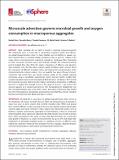| dc.contributor.author | Shen, Rachel | |
| dc.contributor.author | Borer, Benedict | |
| dc.contributor.author | Ciccarese, Davide | |
| dc.contributor.author | Salek, M. Mehdi | |
| dc.contributor.author | Babbin, Andrew R. | |
| dc.date.accessioned | 2024-06-03T21:25:30Z | |
| dc.date.available | 2024-06-03T21:25:30Z | |
| dc.date.issued | 2024-04-23 | |
| dc.identifier.issn | 2379-5042 | |
| dc.identifier.uri | https://hdl.handle.net/1721.1/155171 | |
| dc.description.abstract | Most microbial life on Earth is found in localized microenvironments that collectively exert a crucial role in maintaining ecosystem health and influencing global biogeochemical cycles. In many habitats such as biofilms in aquatic systems, bacterial flocs in activated sludge, periphyton mats, or particles sinking in the ocean, these microenvironments experience sporadic or continuous flow. Depending on their microscale structure, pores and channels through the microenvironments permit localized flow that shifts the relative importance of diffusive and advective mass transport. How this flow alters nutrient supply, facilitates waste removal, drives the emergence of different microbial niches, and impacts the overall function of the microenvironments remains unclear. Here, we quantify how pores through microenvironments that permit flow can elevate nutrient supply to the resident bacterial community using a microfluidic experimental system and gain further insights from coupled population-based and computational fluid dynamics simulations. We find that the microscale structure determines the relative contribution of advection vs diffusion, and even a modest flow through a pore in the range of 10 µm s−1 can increase the carrying capacity of a microenvironment by 10%. Recognizing the fundamental role that microbial hotspots play in the Earth system, developing frameworks that predict how their heterogeneous morphology and potential interstitial flows change microbial function and collectively alter global scale fluxes is critical. | en_US |
| dc.language.iso | en_US | |
| dc.publisher | American Society for Microbiology | en_US |
| dc.relation.isversionof | 10.1128/msphere.00185-24 | en_US |
| dc.rights | Creative Commons Attribution | en_US |
| dc.rights.uri | https://creativecommons.org/licenses/by/4.0/ | en_US |
| dc.source | American Society for Microbiology | en_US |
| dc.title | Microscale advection governs microbial growth and oxygen consumption in macroporous aggregates | en_US |
| dc.type | Article | en_US |
| dc.identifier.citation | Shen R, Borer B, Ciccarese D, Salek MM, Babbin AR. 2024. Microscale advection governs microbial growth and oxygen consumption in macroporous aggregates. mSphere 9:e00185-24. | en_US |
| dc.contributor.department | Massachusetts Institute of Technology. Department of Earth, Atmospheric, and Planetary Sciences | |
| dc.contributor.department | Massachusetts Institute of Technology. Department of Biological Engineering | |
| dc.relation.journal | mSphere | en_US |
| dc.eprint.version | Final published version | en_US |
| dc.type.uri | http://purl.org/eprint/type/JournalArticle | en_US |
| eprint.status | http://purl.org/eprint/status/PeerReviewed | en_US |
| dspace.date.submission | 2024-06-03T21:23:12Z | |
| mit.journal.volume | 9 | en_US |
| mit.journal.issue | 4 | en_US |
| mit.license | PUBLISHER_CC | |
| mit.metadata.status | Authority Work and Publication Information Needed | en_US |
